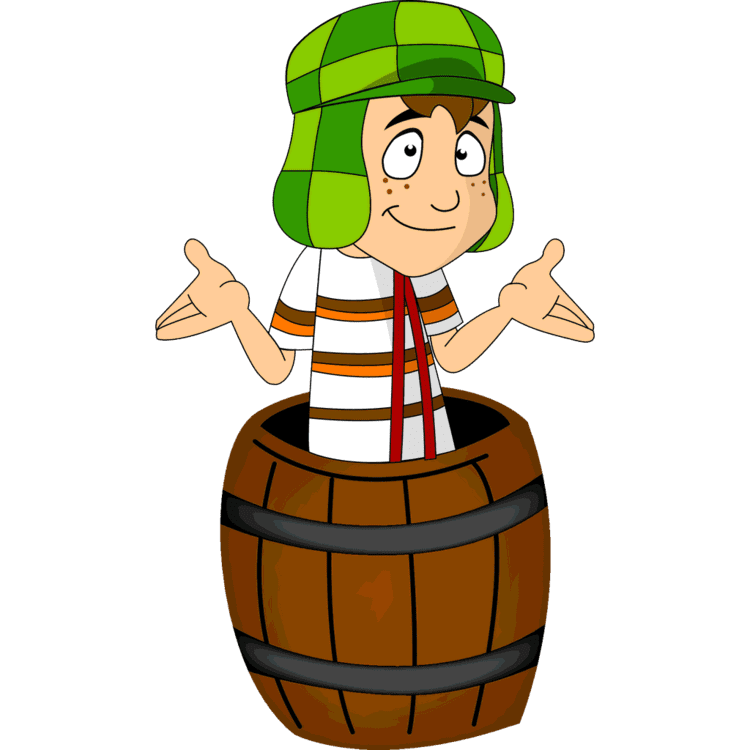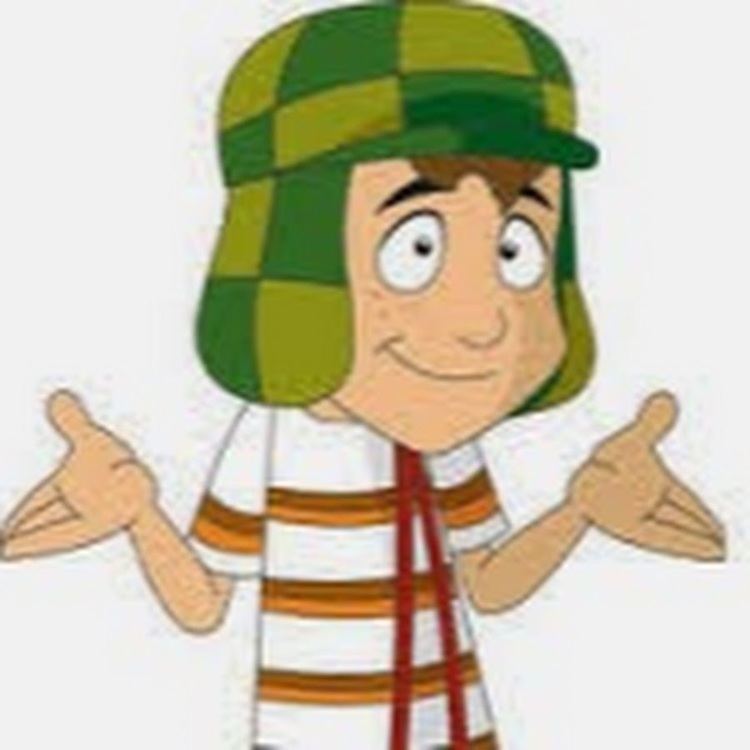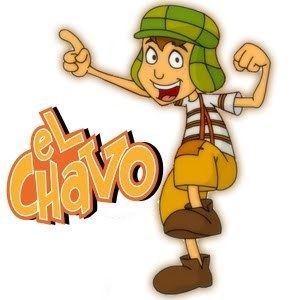6 /10 1 Votes
Opening theme "El Chavo" Final episode date 6 June 2014 | 6/10 IMDb First episode date 21 October 2006 | |||||||||||||||||||||||||||||||||
 | ||||||||||||||||||||||||||||||||||
Genre ComedyAnimationSlapstickSatire Based on Characters created byRoberto Gómez Bolaños Developed by Roberto Gómez Fernández Voices of Jesús GuzmánSebastián LlapurMario CastañedaErica EdwardsMoisés Suárez AldanaErika MirelesSebastián LlapurMaggie VeraLeonardo GarcíaJulieta Rivera Theme music composer Herrera Pérez AdriánAlejo Flores Luis Fernando Networks YouTube, Televisa, Sistema Brasileiro de Televisão, Cartoon Network, Kabillion, Canal 5, Boomerang Cast Yuri Lowenthal, Mona Marshall, Tara Platt, Kate Higgins, Doug Erholtz Similar El Chavo del Ocho, Chespirito (TV series), ¡Mucha Lucha! Profiles | ||||||||||||||||||||||||||||||||||
El Chavo Animado (also known as El Chavo: The Animated Series) is a Mexican animated series based on a live-action TV series El Chavo del Ocho, created by Roberto Gómez Bolaños with a same series creator who created the live-action TV series El Chavo del Ocho.
Contents
- Cast and characters
- Additional voices
- Background
- English dub
- American names
- Challenges and differences with the original series
- Localization and changes in English version
- 1st season 20062007
- 2nd season 20072008
- 3rd season 20082009
- Spin offs and merchandise
- Video games
- El Chapulin Colorado Animado
- Broadcast
- References

After several years of successful reruns of the original series, Televisa launched simultaneously in Mexico, and the rest of Latin America, an animated version of the program made by Ánima Estudios on October 21, 2006 to capitalize on the nostalgia and popularity of the original series. Along with the series, Televisa launched a huge marketing campaign that included merchandise tie-ins to capitalize on the expected success of the show. For the series launching event a full set was built imitating the computerized background, where a presentation showed how the animation was made. Many elements of the original series, including most of the original stories were included in the animated series.

The series aired via Kabillion On Demand in English in North America. Despite appearing in the video-on-demand service, the series did not appear or was mentioned on the official Kabillion website until the relaunch of the site in April 2012, after which the series was placed there. The series is also available on YouTube in multiple languages.

As of 29 April 2014, the show has been renewed for a seventh season. Doctor Chapatín makes a guest appearance in the episode "Quico se manchó". It is confirmed that the next season will introduce "La Chilindrina" (Mr. Raimond's daughter) back to the cast, as confirmed by Roberto Gómez Fernandez. The character was initially unavailable for the creators of the animated series as the concept was not originally by Chespirito, but rather by Maria Antonieta de Las Nieves (who played the role in the original show and several others).

Cast and characters
Additional voices
Background
The cartoon depicts the children in the right scale compared to the original live action series where the children were played by adults, and the feel was given to the character through their way of dressing, speaking, and mainly through giving them oversized toys.
But this was not the first attempt to animate the characters of the show. Previously, claymation sequences were created for the credits of the original series in the late 1970s. and 2D animations were used for a "submarinos marinela" commercial, and later for the credits of "Chespirito", the program that succeeded both "El Chavo" and its sister series El Chapulín Colorado.
In this animated series, La Chilindrina, one of the most popular characters of the original show, doesn't appear due to on-going disputes between María Antonieta de las Nieves and Roberto Gómez Bolaños on the copyrights of the character. At the time of production, De las Nieves had and still has the rights of the Chilindrina Character and didn't come to an agreement with the producer of the show, one of the sons of Gómez Bolaños and also a noted Televisa executive, over royalties. De las Nieves won the copyrights of the character on the basis that it was based on her persona and the traits of the character brought forth by her, and presented in previous characters she performed prior to the conception of the show. However the Gomez Bolaños estate claims that Roberto Gómez as the show writer, created the character and De las Nieves only portrayed it, and as such owns the rights to the character. Although the character was included on the original launching materials, it was removed from the final production.
English dub
The series was later dubbed into English and aired in Kabillion's video-on-demand which featured major changes to the basic style of the original El Chavo series:
The English translation was done by Fabiola Stevenson, a Mexican director and voiceover artist residing in Los Angeles, California who was hired by The Dubbing House a Mexican Post Production house. The English version is the only El Chavo cartoon series with a sung intro as all of the other dubs have instrumental music instead. Fabiola Stevenson and Javier Ponton are now finished with Americanizing the series and only 52 episodes of all episodes are in English. The recording was done at Henckahontas Studios, in Burbank California. English production for the show started in 2009 and has been completed.
American names
Chavo, Gloria and Quico are the only characters whose names have not been Americanized or changed. Although Paty's name sounds the same, the American version adds another "t" to the name.
Challenges and differences with the original series
Being El Chavo a popular TV series that hold most of the fun in the severely repeated gags that takes the public to a simple story, there were at the beginning not much ideas to develop in the animated version. Also the Chilindrina character was pulled out due to the legal problems with Maria Antonieta de las Nieves, being this character "substituted" by Ñoño, that becomes one of the main characters (in the original series, Ñoño was a recurring character due to being performed by Edgar Vivar and seldom appeared when Señor Barriga was present). When the story shows necessary to bring more girls, Popis and Paty, a guest characters in the original series become a recurring characters and later one of the main characters.
The first season chapters were animated adaptations of the most popular episodes of the original series even ending with the last episode that had the classic cast together (Vacaciones en Acapulco). From second season and beyond, the series became to show original stories and new guest characters. For example, instead of having El Chapulin Colorado as the main superhero, they also add El Justiciero Enmascarado, a luchador-esque superhero to the kids imagination. Also, the characters have adventures outside the neighborhood so they were able to visit museums, the zoo, entertainment parks and more.
Also, due to the orientation to child audience, the physical and spoken violence that normally rounds around the original series, were softened to show a more cartooned violence. Sometimes, the characters shows some Mexican popular culture themes inside the episodes (for example, Quico refers to a vacation where he fell out to a river, mirroring the Edgar se cae meme where he takes the part of Edgar and Ñoño the part of Edgar's cousin).
Every depiction of violence from adults towards children from the original series was removed too. The most notorious is Don Ramon's custom of hitting Chavo after he annoys him. Instead of that, Don Ramon simply turns to the camera with an angry expression.
Localization and changes in English version
The episode "La mascota de Quico" (Trial and Terror in English) was changed during the English version. In the Spanish and Portuguese versions, Quico's pet cat dies due to being run over by Chavo. The English version states that the cat ran away and the censorship about both scenes of the killed Cat was replaced in the English version with Chavo ashamed and the hospitalized cat in the wheels.
The episode "Una Mosca en el Cafe" (Bread and Butterflies in English) featured a dubbing change. In the Spanish and Portuguese versions, Chavo calls flies "mosca" (fly in Spanish). The English version features Chavo calling them "what'cha ma call'ems" (Los Churruminos) thinking that they are imaginary creatures in his head. Also in that episode, "La Fonda de Dona Florinda" became "Mrs. Worthmore's Cafe". To adapt the series for American viewers, the Mexican cuisine such as sopa de tortilla, arroz con leche, enchiladas and caldo de pollo gets replaced with the American diet and cuisine such as hot dogs (with sauerkraut), hamburgers, soups (presumably chicken noodle soup), chocolate cake, rice bowls and spaghetti and meatballs. Pancakes existed in both versions but it was called hotcakes in the Spanish version while just "pancakes" in the English version. Also in that episode, when everyone laughed at Junior for the third time, he said to the professor "¡Mírelo, eh!" (Did you see that huh? or "I hear That! I hear That!") in the original version while the English version, he said "You see Professor?". Also in that episode, Professor Girafalde gave the bad kids "zeros" in the original version while the English version, he gives them "D's", an American grade letter (although "F" is worse than a "D", which Quico made a mistake of asking the teacher for it).
In the episode "El juego de beisbol" (Know Hitter's in English), Chavo pretends to be a goalkeeper from several soccer national teams including the ones from Peru, Germany, Italy, Switzerland, Argentina and Mexico. When he said he's from Mexico, he is referencing to the fact that the original Mexican version, the vecindad is from Mexico, meaning that the English version's localization is changed to the United States. Although Jesus Guzman (voice actor for Chavo in Spanish dub) says he's the goalkeeper of Mexico in Spanish, it could be a coincidence, the famous football player Cuauhtemoc Blanco is mentioned but in English version is quiet about Mexican football players.
In the episode "Amar a los enemigos" (Love thy Enemy in English), Professor Girafalde asks Chavo to explain from the beginning "why Quico's crying", Chavo mentions "Adam and Eve" in the English version (not the Spanish version) meaning that the series does take place in America in the English version and Chavo's religion is a Christian, and with censorships.
In the episode "Futbol Americano" (Kickin It in English), the kids play American football but it wasn't called (American) football in the English version meaning it's another reference to the fact that the series takes place in the USA at the English version.
In the episode "Los bomberos" (Fire in the Hole in English), when Chavo and Quico were playing astronauts, during the computer animation shots of the rocket, a Mexican flag is seen, one of the things AF The Dubbing House seemed to miss on their censors in Americanization.
In the episode "Los globos" (Ballooney in English), when Mr. Raymond was thinking about children in his imagination (drawn in a children's like art style), a grave appeared with his hat on it and it's engraved "Don Ramón" with a Christian symbol and Ramon Valdez's actual birth and death (Don Ramón is Mr. Raymond's original Spanish name from the original series). Meanwhile, it is a sign that he's also Christian like Chavo.
In the episode "¡Como suben los alimentos!" ("What Goes Up, Must Come Down in English), when Chavo was mentioning about Adam and Eve (played by Worthmore and Girafalde), he stated that they moved to New York and ate the apple in which they were kicked out because they couldn't pay the rent from God (played by Beliarge). Since the Adam and Eve scene was a play on the Chavo cast, it means that the American's relocation is in New York and not in Mexico.
In the episode "El Hombre Invisible" (Invisible Man in English), it is mentioned many cities in Mexico, like Guadalajara, Monterrey, Chimpancingo, Cuernavaca, etc. But in English version it is not mentioned.
When Manny's apartment is shown, there is a picture frame of "Tangamandapio". The picture wasn't Americanized into "Upsidedowntown". Possibly because the picture was too dark and deep to be noticed.
Everytime Girafalde's classroom is shown, one of the posters on the wall is a Mexico map. Since the English versions new location is at New York City, the map should have been American (maybe due to the fact that the picture was too dark and deep to be noticed).
In the episode "Deudas a pagar y sillas a pegar" (Chair Repair in English), there was a scene showing Cristóbal Colón in a burial with the sign Tangamandapio on the covers. In the English version, the word was edited and replaced with Christopher Columbus, possibly to edit reference to Mexican culture. Ironically, both of the dubs were talking about Columbus but with different pronunciations; the Spanish variation Colón and the English variation Columbus.
In the episode "Vamos al circo" (Let's Go to the Circus in English), the attractions featuring an annoyed short man with male pattern baldness, a barking duck and a three legged dog. In the original version, the man was known as "El enano mas alto del mundo" (The world's tallest midget) while the English version, he is known as "The world's baldest man". That wasn't the correct translation unlike the other attractions "Perro de tres Patas" (Three-legged dog) and "Pato que ladra" (Barking Duck) which were actual translations. Possibly because they thought the word "midget" would be offensive for children.
In the episode "Un bebé en la vecindad" (Baby Talk in English), the title for the episode in the original version shows Chavo, Quico, Dona Florinda and Don Ramon looking at the baby who is showing his arms (one of them holds a rattle) wanting to be picked up. The English version, the title picture is changed to a still picture of the baby in a basket shaking his rattle, for a mysterious reason and the original name of the baby is "Panfilo" so in English dub that name is not used.
1st season (2006–2007)
The original title is in Spanish which aires in Canal 5. The American title is the English version which aires in Kabillion in which the English titles are based on popular American phrases or sayings, not actual translations. The French title is for the French dub and the Portruguese title is for the Brazilian version of El Chavo.
2nd season (2007–2008)
The original title is in Spanish which aires in Canal 5. The American title is the English version which aires in Kabillion in which the English titles are based on popular American phrases or sayings, not actual translations. The French title is for the French dub and the Portruguese title is for the Brazilian version of El Chavo. This is the last English Dubbed season of the El Chavo cartoon series as Fabiola Stevenson has completed her ordered 52 episodes.
3rd season (2008–2009)
The original title is in Spanish which aires in Canal 5. The American title is the English version. The French title is for the French dub and the Portruguese title is for the Brazilian version of El Chavo. At present, it's not known if any of the future episodes will be in English as Fabiola Stevenson has completed her ordered 52 episodes.
Spin-offs and merchandise
Televisa has released 6 episodes of El Chavo in Mexico in 2007. In Brazil the same collections are released by Universal Video Entertainment in 2008 under the title Chaves em Desenho Animado. In 2004 were launched dolls in Mexico representing Quico, La Popis (Phoebe), Don Ramón (Mr. Raymond), Doña Florinda (Mrs. Worthmore) y Profesor Jirafales (Professor Girafalges). In 2006, McDonald's and Bimbo Products launched another six dolls, there's a new videogame of Nintendo DS that will be launched in Mexico but still doesn't have dates this premiere, will in Latin America with Spanish and Portuguese calls "El Chavo animado: El videojuego", and launched a CD with soundtrack of El teatro del Chavo Animado, in Mexico, with songs basen in the original series and El Chapulin Colorado too.
A stage show based on the animated series, featuring actors in full body costumes with masks, and a music soundtrack based on updated versions of the songs used in the live show has toured several cities.
A Facebook game was released in March 2012 called La Vecindad del Chavo where the player designs his own neighborhood kid and shares missions with the other characters of the Vecindad in order to increase the friendship with them and also joins them in actions like clearing the neighborhood, playing some games in the vicinity or inside the imagination of the kids (like a Star Wars-esque game where the play must shut down Quico ships before they escape). The game was developed by Playful Play studios in Monterrey, Mexico.
Video games
A video game based on the series was released on April 27, 2012 for the Wii and is a Mario Party like game where the players can play some Mexican games in order to win points. The game was developed by Kaxan Media Group and was developed by Slang Publishing and Televisa Home Entertainment. It is only available in Mexico.
In 2014, another game named El Chavo Kart was released for multiple platforms, such as Xbox 360 and PlayStation 3. Like the previous game, it's also based on the animated series and its gameplay is loosely based on Mario Kart series.
El Chapulin Colorado Animado
Building on the success of "El Chavo Animado," which spanned 7 seasons and 139 episodes across various platforms, Televisa, in collaboration with Ánima Estudios, launched "The Chapulin Animado." The first episode debuted online and on YouTube in April 2015, followed by a television release on July 26, 2015.
Broadcast
El Chavo is broadcast on the following stations around the world:
